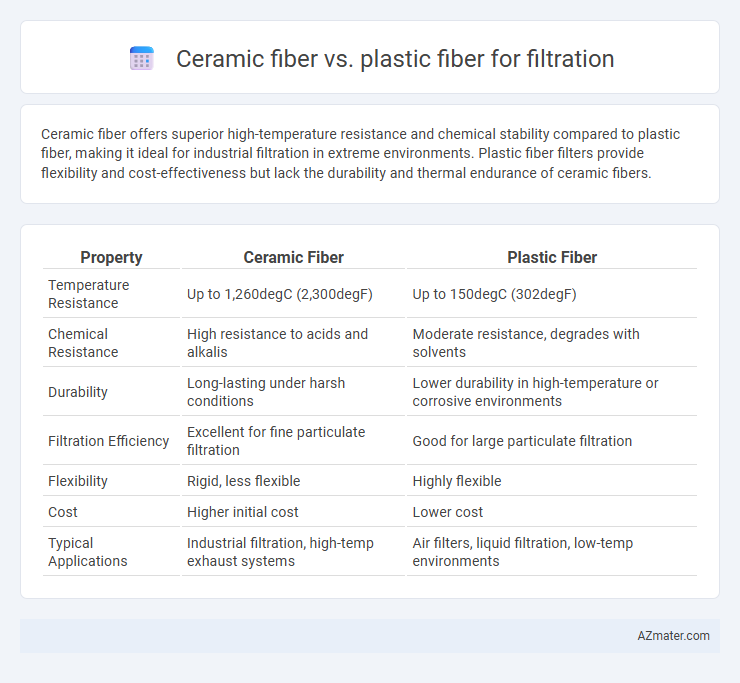Ceramic fiber offers superior high-temperature resistance and chemical stability compared to plastic fiber, making it ideal for industrial filtration in extreme environments. Plastic fiber filters provide flexibility and cost-effectiveness but lack the durability and thermal endurance of ceramic fibers.
Table of Comparison
| Property | Ceramic Fiber | Plastic Fiber |
|---|---|---|
| Temperature Resistance | Up to 1,260degC (2,300degF) | Up to 150degC (302degF) |
| Chemical Resistance | High resistance to acids and alkalis | Moderate resistance, degrades with solvents |
| Durability | Long-lasting under harsh conditions | Lower durability in high-temperature or corrosive environments |
| Filtration Efficiency | Excellent for fine particulate filtration | Good for large particulate filtration |
| Flexibility | Rigid, less flexible | Highly flexible |
| Cost | Higher initial cost | Lower cost |
| Typical Applications | Industrial filtration, high-temp exhaust systems | Air filters, liquid filtration, low-temp environments |
Overview of Ceramic Fiber and Plastic Fiber Filtration
Ceramic fiber filtration offers superior thermal stability and chemical resistance, making it ideal for high-temperature industrial applications such as gas and liquid filtration. Plastic fiber filtration provides lightweight, flexible, and cost-effective solutions suitable for low to medium temperature environments, including air and water purification. Both fibers optimize filtration efficiency based on application-specific temperature and chemical exposure requirements.
Key Material Properties: Ceramic vs Plastic Fibers
Ceramic fibers exhibit exceptional thermal resistance, maintaining structural integrity at temperatures exceeding 1000degC, while plastic fibers typically degrade beyond 250degC, limiting their high-temperature applications. The chemical inertness and low thermal conductivity of ceramic fibers enhance filtration efficiency and durability in harsh environments, compared to plastic fibers that may suffer from chemical attack and deformation. Ceramic fibers also offer superior mechanical strength and dimensional stability, making them ideal for demanding filtration processes requiring long-term reliability.
Filtration Efficiency Comparison
Ceramic fiber filtration exhibits superior efficiency in high-temperature applications due to its thermal stability and chemical resistance, enabling effective capture of fine particulate matter above 1000degC. Plastic fibers, while offering lower filtration efficiency at elevated temperatures, perform well in capturing larger particles in low to moderate temperature environments below 200degC. The inherent porosity and durability of ceramic fibers result in higher dust loading capacity and improved filtration longevity compared to plastic-based fibers.
Temperature and Chemical Resistance
Ceramic fiber offers superior temperature resistance, withstanding environments up to 1260degC to 1600degC, making it ideal for high-temperature filtration applications compared to plastic fibers, which typically degrade above 250degC. Chemically, ceramic fibers exhibit excellent resistance to acids, alkalis, and solvents, whereas plastic fibers such as polyester or polypropylene are susceptible to chemical degradation and melting. This makes ceramic fibers a preferred choice for harsh industrial filtration systems requiring durability under extreme thermal and chemical conditions.
Longevity and Durability
Ceramic fiber exhibits superior longevity and durability compared to plastic fiber in filtration applications due to its high resistance to extreme temperatures, chemical exposure, and mechanical wear. Plastic fibers tend to degrade faster under harsh conditions, leading to reduced filtration efficiency and more frequent replacements. The inherent thermal stability and chemical inertness of ceramic fibers make them ideal for long-term, heavy-duty filtration environments.
Cost Analysis: Ceramic Fiber vs Plastic Fiber
Ceramic fiber offers higher thermal resistance and chemical stability than plastic fiber, resulting in longer service life and lower replacement costs in high-temperature filtration applications. Plastic fibers generally have lower upfront costs but may incur higher maintenance and frequent replacement expenses due to lower durability and heat tolerance. Cost analysis should consider total lifecycle expenses, including material cost, operational efficiency, and downtime frequency for optimized filtration performance.
Environmental Impact and Sustainability
Ceramic fiber filtration media exhibit superior environmental sustainability due to their high-temperature resistance and long service life, reducing waste and energy consumption through durability and recyclability. Plastic fibers, although lightweight and cost-effective, often have a shorter lifespan and contribute to microplastic pollution, raising concerns about ecological impact during and after use. The choice of ceramic fiber supports lower carbon footprints and promotes sustainable filtration solutions in industrial applications.
Application Suitability Across Industries
Ceramic fiber offers exceptional thermal resistance and chemical stability, making it ideal for high-temperature industrial filtration in steel manufacturing, power plants, and petrochemical processes. Plastic fiber, such as polypropylene and polyester, is suited for lower temperature applications like water treatment, air purification, and food processing due to its flexibility and chemical compatibility. Selecting between ceramic and plastic fibers depends on the specific operational temperature ranges, chemical exposure, and filtration efficiency required by different industries.
Maintenance Requirements and Ease of Use
Ceramic fiber filters require minimal maintenance due to their high thermal stability and resistance to chemical corrosion, making them ideal for harsh industrial environments. Plastic fiber filters, while easier to handle and install because of their lightweight and flexible nature, often demand more frequent cleaning or replacement due to lower durability and susceptibility to chemical and heat degradation. The maintenance efficiency and operational longevity of ceramic fiber filters significantly reduce downtime and associated costs compared to plastic fiber options in filtration systems.
Choosing the Right Fiber for Filtration Needs
Ceramic fiber offers high-temperature resistance up to 1260degC, making it ideal for industrial filtration in furnace and kiln environments, while plastic fiber excels in low-temperature applications with excellent chemical resistance and flexibility. Selecting the right fiber depends on filtration conditions, with ceramic fibers suited for harsh thermal and chemical settings, whereas plastic fibers provide cost-effective solutions for filtration at ambient or moderate temperatures. Evaluating factors such as temperature tolerance, chemical exposure, mechanical strength, and cost ensures optimal performance and longevity in filtration systems.

Infographic: Ceramic fiber vs Plastic fiber for Filtration
 azmater.com
azmater.com